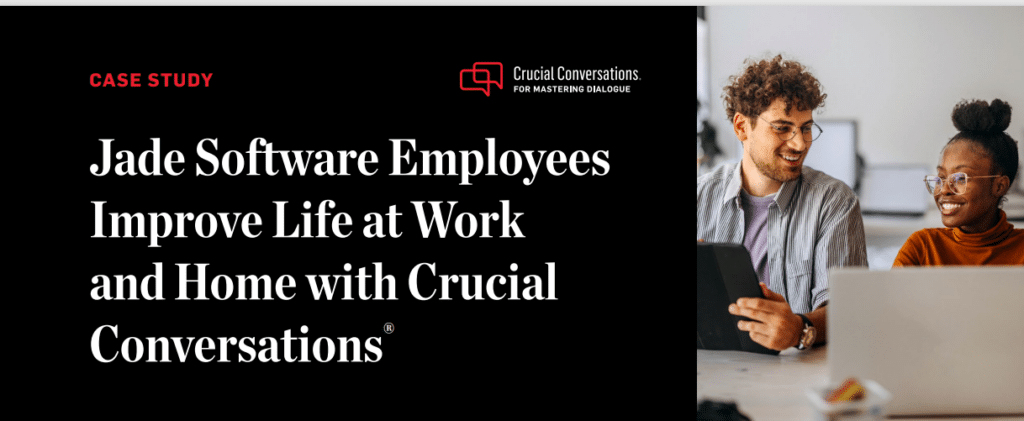When we look at how we approach Crucial Conversations and what we do in the moment, it pays to pay attention to our behaviour.
How do we react? How do we respond?
Do we clam up and go silent, or do we choose more aggressive strategies and become controlling?
It also pays to think about how others respond to us. Do they turn silent or violent?
We’ve previously looked at the motives of our dialogue to identify what we really want to achieve in a conversation. To get the results we care most about, we need to make sure our motives are in sync with our behaviour.
This has serious implications for nearly every aspect of our lives — our work projects, personal relationships, new director or employee issues, marriage issues, and community issues.
To help us understand how to make sure our emotions and behaviour are in sync, I’m going to introduce you to what we call The Path to Action.
At VitalSmarts, we often use this saying: Our stories create our emotion, and we create our stories.
This saying is the underlying wisdom behind The Path to Action, a framework that helps us better understand what’s happening to us during a crucial conversation.
1. See & Hear
First, we take in information through our eyes and ears. Throughout our day, we see and hear everyone’s actions towards us.
Maybe we see an email that was CC’d to someone who shouldn’t have been CC’d, or we overhear a water cooler conversation that affects us.
2. Tell A Story
The next thing that happens, naturally and biologically, is our brain tells a story about what we just experienced to make sense of what happened.
3. Feel
As biological and emotional beings, this story causes us to feel something about what happened.
4. Act
Our emotions then cause us to take action. If we’re not careful, we either clam up or go violent and before we know it, we’re in the middle of a crucial conversation that could go horribly wrong.
Let me give you an example.
Years ago, I was working as part of a regional sales team that was extremely successful and experienced. We were very autonomous, and we loved this part of our job.
Eventually, our leader left and we got an interim manager who acted as more of a manager than a leader.
Three to four times a day, she’d approach us to check every proposal that went out — even at the earliest stages as they were first being written. She also wanted to monitor our phone calls with internal departments and other daily affairs.
The thing is, she didn’t explain the context or debrief us as to why she was managing us this way.
We began to tell ourselves some pretty colourful stories about why she was doing this.
What’s going on? She doesn’t trust me. She doesn’t think I’m competent enough. She doesn’t know how experienced we are. She’s micromanaging me.
The feelings from the stories we were telling ourselves weren’t so grand.
I was personally feeling frustrated, hurt, unappreciated, and unacknowledged, so I reacted by turning to avoidance. I avoided her and stopped contributing in our meetings, and this behaviour went on for a while. It really wasn’t fun to be in that environment.
I wasn’t frustrated because the manager walked into my office three times each day. I was frustrated because of the story I told myself about why she was checking on me.
I didn’t know for certain she didn’t trust me, but because that was the story I told myself, my emotions flared and I allowed it to affect my behaviour, instead of having a crucial conversation.
I want to invite you to think about these three takeaways about The Path to Action we all experience in our daily lives.
1. This is part of life.
There’s no graduating from this process, but understanding it is a skill and we can work at and improve.
2. Take your stories lightly.
We need to recognise that our stories comes from within and treat them tentatively before we take them as facts. It’s easy to jump to the conclusion that the other person wants to hurt us, make a fool out of us, etc.
When we treat these stories tentatively, we open ourselves up to the possibility that the other person’s intention may be different than what we expected.
2. We have the power to choose our attitude.
In his masterpiece, Man’s Search For Meaning, Viktor Frankl said, “Everything can be taken from a man but one thing: the last of human freedoms – to choose one’s attitude in any given set of circumstances, to choose one’s own way.”
When we’re in the middle of an emotional, crucial conversation, this isn’t the easiest thing to remember but it can be incredibly self-empowering.
When we become aware this process happens in all our interactions, we can choose to hold on to our stories lightly. We can withhold an emotional action until we get into the crucial conversation and discover more about what’s really happening. Only then can we get the outcomes we really want.





